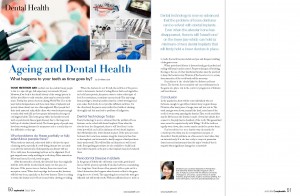 This article first appeared in the July 2014 issue of Ezyhealth magazine. We have reproduced it for the information of those of you who missed it when it was published.
This article first appeared in the July 2014 issue of Ezyhealth magazine. We have reproduced it for the information of those of you who missed it when it was published.
Good nutrition and medical care has enabled many people to live to a ripe old age. Life expectancy now exceeds 80 years. However, if we look at the dental history of the average person in his/her late fifties-to-mid seventies, there may be several notable issues. Firstly, this person was born during World War II or in the years before Independence and those were times of upheaval and poverty where dental care was often neglected. Most people had their teeth extracted early, while others who were fortunate enough to retain their teeth did not have proper information about good oral hygiene habits. This latter group either has heavily-restored teeth or periodontal disease (gum disease) due to the long-term build-up of calculus (dental tartar). The former group of people may have been wearing dentures for many years and as a result, they too face difficulties as they age.
What problems do these partially or fully ed
entulous people face?
When teeth are extracted, other teeth drift or tilt into the space of missing teeth, especially if a well-fitting denture was not made soon after the extraction(s). Subsequently, any denture will not fit too well, since the remaining teeth are not in alignment. Food gets trapped more easily, resulting in tooth decay. More extractions follow until most, if not all, teeth are gone.
After the extraction of teeth, the (alveolar) bone that originally held the teeth will be resorbed (melt away) over the span of a few years. If the person wears a denture, then even more bone resorption occurs. When the bony ridge has become flat, dentures will feel very loose, especially on the lower denture. There is nothing to retain the denture and it “floats” around when chewing or talking.
When the dentures do not fit well, the nutrition of the person starts to deteriorate. Instead of eating fibrous fruits and vegetables and solid meat protein, the person starts to select softer types of food for convenience, sometimes unconsciously. This may range from porridge to bread (possibly soaked in a sweet beverage) and even cakes. Such foods do not provide sufficient nutrition. On the other hand, the person may swallow food without chewing thoroughly and this may lead to problems of indigestion.
Dental Technology Today
Dental technology is now so advanced that the problem of loose dentures can be solved with dental implants. Even when alveolar bone has disappeared, there is still “basal bone” on the lower jaw which can hold (a minimum of two) dental implants that will firmly hold a lower denture in place. If the person is more fortunate that some bone remains along the lower jaw, then 4 or 5 implants can be inserted to finally support a fixed prosthesis (man-made teeth). This will feel like and function as well as real teeth. Bone grafting procedures are also available to “build back” bone where required on the jaw so that implants may also be placed there.
Periodontal Disease in Elderly
In the group of elderly who still retain some teeth, periodontal disease will be present, especially if calculus had been accumulating for a long time. Gum disease often presents with no pain and is a “silent” destruction that happens when bacteria collects in the gums along the roots of teeth. The supporting bone around the teeth gets inflamed and will slowly resorb. Without sufficient bone to hold on to teeth, the teeth become mobile and pus and frequent swelling of the gums occur.
When periodontal disease is detected early, good professional scaling will keep it under control. Proper techniques of brushing, flossing or the use of other interdental brushes must be practised to keep the bacteria away. However, if the bone loss is too severe, then extraction of the tooth/teeth will be necessary.
Gum disease is also closely linked to diabetes and heart disease. The bacteria that accumulate and cause inflammation in the gums also play a role in the control or progression of diabetes and heart disease.
Conclusion
In the population, there will be some individuals who are fortunate enough to age without dental decay or gum disease. However, after many years of usage, wear and tear sets in. The teeth may get worn down; enamel (the hard, outer layer of the tooth) is worn away, exposing the dentine. Then tooth sensitivity may be felt because the dentine is made of very fine tubules that connect to the pulp (nerve chamber) of the tooth. This generalized wear cannot be repaired easily with “fillings”. If all the teeth are equally worn down, then crowns may be needed to protect them.
Our best advice is to see a dentist every 6 months for a check-up even when you do not experience any pain or discomfort. Dental problems are often easier to treat when they are detected early. It is also less costly to carry out preventive dental care and maintenance than the major “overhaul” that is required when significant damage has occurred.
Dr Hel ena Lee is a Dental Specialist in Periodontics with Specialist Dental Group®, Singapore.She is also an Adjunct Lecturer with the National University of Singapore. Dr Lee has a special interest in dental implants, gingival plastic surgery, and tissue grafting. For more information, visit www.specialistdentalgroup.com
ena Lee is a Dental Specialist in Periodontics with Specialist Dental Group®, Singapore.She is also an Adjunct Lecturer with the National University of Singapore. Dr Lee has a special interest in dental implants, gingival plastic surgery, and tissue grafting. For more information, visit www.specialistdentalgroup.com





